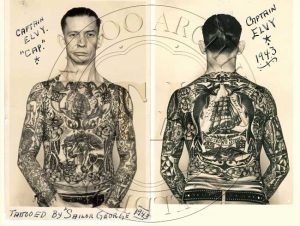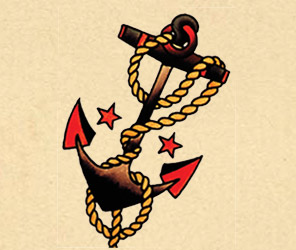Old School Sailor Tattoos I
Crossing the imaginary seas
It looks as if travel is off the cards again, at lest for the near future. In place of being able to hop around the world, or even across the continent or the country, we thought we’d honour the nomadic tradition of modern tattooing. This post takes a look at the iconic imagery of the sailor tattoo, its symbolism, and the culture that sprang up around it.

Polynesian origins
The commonly held belief is that sailors began getting tattooed extensively after British explorer Captain James Cook’s journey to the Pacific in the 18th century. Inspired by indigenous islanders traditional tattoos, Western seafarers nonetheless developed their own style and iconography, symbolic of their lifestyle and relationship to the ocean.
As many of the indigenous people they may have come across, they too are at the mercy of the unpredictable elements and the capriciousness of the sea. What may have been a certain felt kinship and collecting of souvenirs, evolved into the basis for the style responsible for popularising tattooing in the 20th century.
Iconography
All seafaring cultures are rich in symbolism and tradition, and so are Western sailor customs. While the first ‘tatus’ may have been souvenirs from Polynesian ‘artists’, sailors soon began tattooing each other. The style grew its own set of iconography. Motives would correspond to a form of superstitious talisman, or signify a postcard and memorabilia from various places the seaman had been stationed at or travelled to.
Anchors and cannons
 When in the navy, sailors get an anchor, perhaps one of the most recognisable sailor tattoos of all time, after crossing the Atlantic Ocean. It also serves as a symbol of stability and a reminder of home, and will often be accompanied by a “mom,” or the name of the wearer’s sweetheart. Those who were boatswain mates (the term for someone responsible for all things relating to marlinespikes, decks, upkeep of ship’s external structure, rigging etc.) would have crossed anchors tattooed in the webbing between thumb and index finger. A pair of crossed cannons, on the other hand, signifies military service.
When in the navy, sailors get an anchor, perhaps one of the most recognisable sailor tattoos of all time, after crossing the Atlantic Ocean. It also serves as a symbol of stability and a reminder of home, and will often be accompanied by a “mom,” or the name of the wearer’s sweetheart. Those who were boatswain mates (the term for someone responsible for all things relating to marlinespikes, decks, upkeep of ship’s external structure, rigging etc.) would have crossed anchors tattooed in the webbing between thumb and index finger. A pair of crossed cannons, on the other hand, signifies military service.
Compass roses
A compass rose was thought to serve as blessing, steering the sailor and his ship on the right course, and allowing them always to find their way back home. Sometimes this could be symbolised by its close symbolic relative the nautical star, usually a five-pointed star in dark and light shades.
Dragons
If a seaman had been to China, either serving at a station there or sailing to a Chinese port, this would be signified by a dragon. If it were gold, this would indicate that he had crossed the international date line.
Ship-rigged 
A tattoo of a fully-rigged ship, sometimes minuscule versions and sometimes grandiose full back pieces, meant that its wearer had sailed past the treacherous waters of Cape Horn, the southernmost tip of South America. The rough seas would force ships to traverse them with all sails fully set. Stories abound of mutinies erupting when captains would embark on the perilous jounrey in unfavorable conditions.
Come back later this week for more imaginary journeys across the seas, and the story of the legendary artist known as Sailor Jerry.
